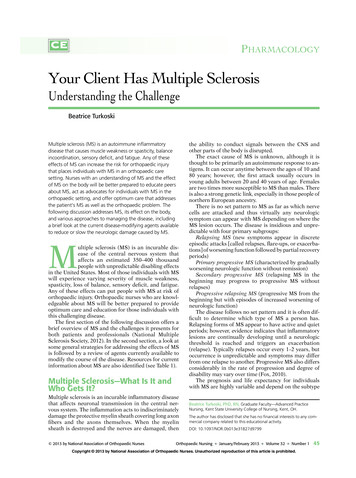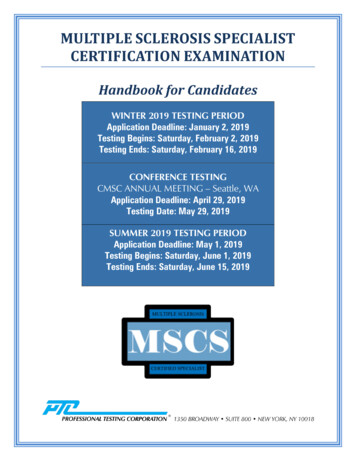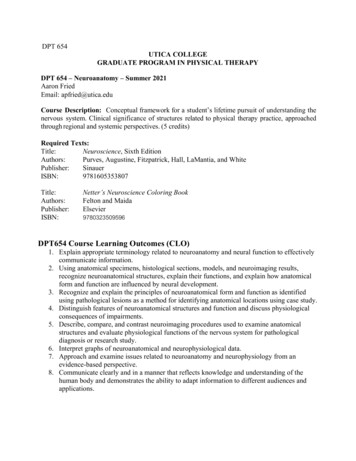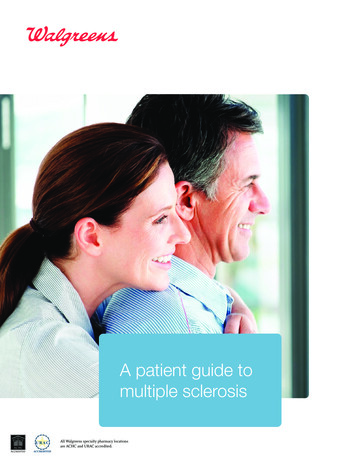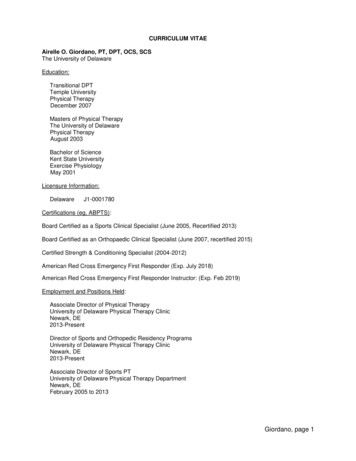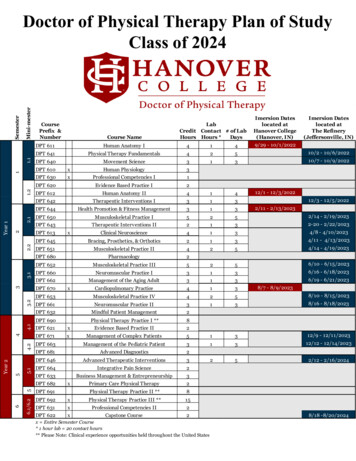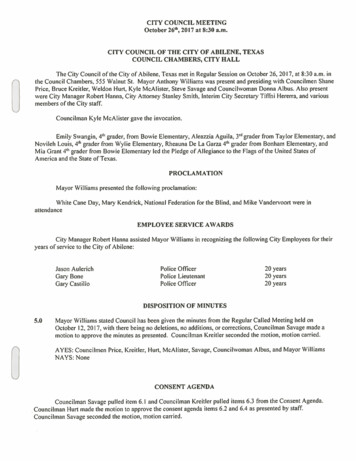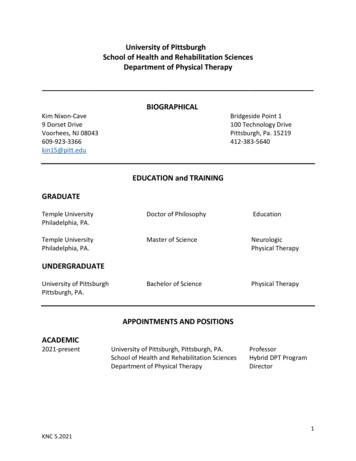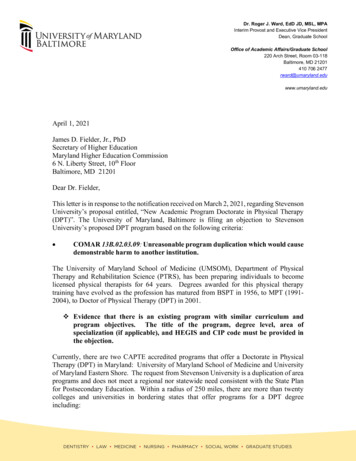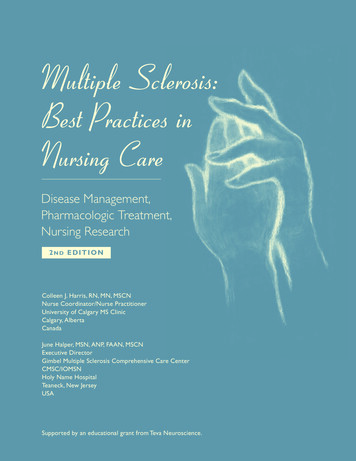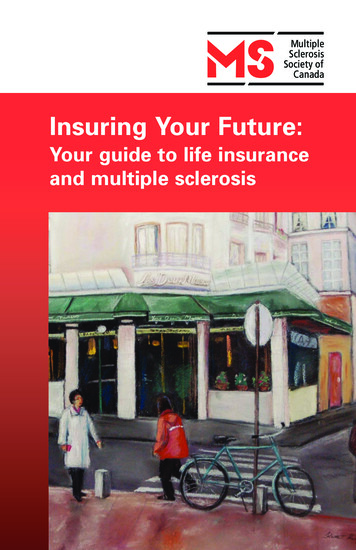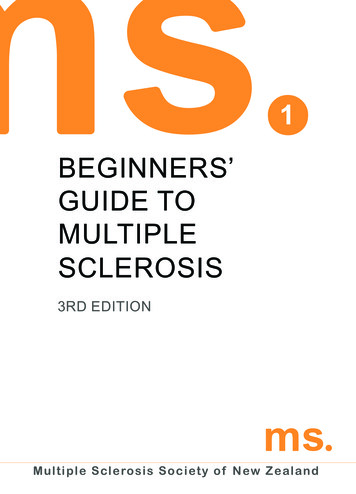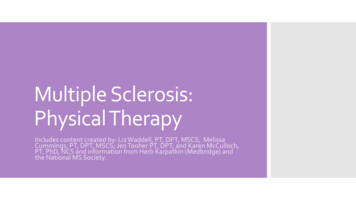
Transcription
Multiple Sclerosis:Physical TherapyIncludes content created by: Liz Waddell, PT, DPT, MSCS, MelissaCummings, PT, DPT, MSCS; Jen Tooher PT, DPT; and Karen McCulloch,PT, PhD, NCS and information from Herb Karpatkin (Medbridge) andthe National MS Society.
1. Choose appropriate assessments,functional outcome measures, andevaluation components for a patient with MSand devise an appropriate treatment plan.Objectives2. Provide appropriate exercise parametersfor someone with MS and discussappropriate education for modifying anexercise plan when needed.
Navigator Subjective examination Self-report measures Objective examination Outcome measures Training techniques and interventions Special exercise considerations Participation and community resources Complimentary and alternative medicine
Patient Goals - What brings you in today? What doyou want out of therapy? Walking, foot drop/tripping, falls, balance, pain, indirectlyrelated to MS, not related to MS, 1x visit for HEP Disease historySubjectiveexamination When were you diagnosed with MS? History of neurologicsymptoms prior to MS diagnosis. History of MS symptomsand how they impact function. General history and overallhealth. History of falls & injuries. Symptom Management Prior physical therapy/interventions. Use of assistiveequipment. Medication for symptoms. Daily Activities and Exercise What is your typical day like? Do you exercise/use othertherapies? What do you want to be able to do that you can’tdo now or can’t do as well as you’d like?
Fatigue Do you experience fatigue related to MS? What contributes to yourfatigue? How long can you walk/stand/work prior to increased fatigue? Thermosensitivity Heat, cold, humiditySubjectiveexamination Personality/Emotional Status, Cognitive dysfunction Motivation, Coping strategies, self-efficacy in disease management Caregiver/Family Support & Resources Who do you live with? Does anyone help you with your daily activities? Medications Disease modifying drugs, Symptom management, Non-MS meds Speech/Swallowing
Subjectiveexamination:comorbidities Common modifiable comorbidities: Depression (50%) Hypertension (30%) Alcohol abuse (14-18%)
Navigator Subjective examination Self-report measures Objective examination Outcome measures Training techniques and interventions Special exercise considerations Participation and community resources Complimentary and alternative medicine
Self-reportmeasuresHighly recommended by MS Edge Task Force: MS Walking Scale (MSWS-12) Dizziness Handicap Inventory (DHI) MS Impact Scale (MSIS-29) MS Quality of Life (MS Qol-54)Recommended Activities-Specific Balance Confidence Scale(ABC) Modified Fatigue Impact Scale SF-36Refer to outcome measure recommendations by theMS Edge Task Force on http://www.neuropt.org/
Navigator Subjective examination Self-report measures Objective examination Outcome measures Training techniques and interventions Special exercise considerations Participation and community resources Complimentary and alternative medicine
Observation, Posture Muscle StrengthObjectiveexamination:neurologicalscreen Flexibility/Spasticty Common spasticity/contractures: quads, hipflexors, adductors, plantarflexors Fatigue VAS 0-10 Fatigue with exam activities Coordination
Somatosensation screen Pts with MS have been shown to demonstrate VORimpairments Corticospinal Signs Skin Integrity Cerebellar Signs Cardiovascular/Pulmonary inspiration/expiration especially with advanced MS
Objectiveexamination:functionalmobility Bed Mobility Transfers Static Balance Wheelchair mobility Postural Control Endurance Gait & Dynamic Balance
Grip Strength/Pinch n UE/wrist/hand ROM. Hand closing and handopening Coordination tests 9 hole peg test Part of the MS Functional Composite T25FWT 9 Hole Peg Test Paced Auditory Serial Addition Test (PASAT) Box & blocks test Functional tasks
Navigator Subjective examination Self-report measures Objective examination Outcome measures Training techniques and interventions Special exercise considerations Participation and community resources Complimentary and alternative medicine
Functionalassessment ofmobility Recommendations from Consortium ofMultiple Sclerosis Centers Conference in2016: TUG 25 foot walk test 5x STS BERG
Navigator Subjective examination Self-report measures Objective examination Outcome measures Training techniques and interventions Special exercise considerations Participation and community resources Complimentary and alternative medicine
Strength Training
Decreased muscle strength Primary Altered central motor drive/activation failure Delayed neural transmission Impaired skeletal muscle metabolism Alterations in cross-bridge mechanicsTrainingtechniques:strength Secondary disuse Associated with Increased falls Decreased gait speed Decreased activity tolerance Decreased postural control Predictor of ambulatory function
Rest at first sign of fatigue Subjective fatigue Change in movement ning Aim for sets and reps that allow forthe greatest total number of reps 10 sets of 3 is better than 2 sets of 10 Use trial and error to determine theminimum amount of rest time needed Rest time may be as little at 10 seconds Minimum 2-3 days/week
Progress weight normally Strength asymmetry May need different exercises for each side.Trainingtechniques:strengthprogression &modifications Concentric & eccentric With control Try at a high speed – uses coordination thatmay be impaired If unable to perform a concentriccontraction Eccentric Isometric (5-10 sec)
When possible, do engthening Standing squat vs leg press Utilizes strength and balance More specific to daily activities Consider a combination of exercisetypes Specific to the persons deficits Can be executed correctly, safely, andindependently In line with their interests
Aerobic/EnduranceTraining
Trainingtechniques:aerobicendurance Aerobic deconditioning may occur fromdecreased activity or primary impairments 30 min moderate intensity aerobic exercise isrecommended at least 2x/wk Intermittent rest breaks may result in greatervolume of exercise Dual task performance- cognitive activitypaired with walking is linked to increased fallsas well as decreased cognitive performance
Trainingtechniques:aerobicexercise Walking Program Bicycle Aim for at least 3 intervals of Aquatic exercisethe same duration Minimum 2-3x/week Treadmill training Progression: Running Increase walkingduration Rowing Decrease rest time Trekking poles Circuit training Increase cardiovascular Body-weightand core effortsupport treadmill Foldable and retractablepolestraining More socially acceptablethan a cane
Balance Training
Postural instability in quiet stance in 50% ofpatients Assessed within 3 months of symptom onsetBalanceDysfunction inEarly MS EDSS 1.7 0.2 (0-5)Kalron 2011
Trainingtechniques:education onbalance STOP, SCAN, PLAN Energy conservation Pacing strategies Assistive devices and orthotics Home safety assessment
Trainingtechniques:balanceTai ChiKick-BoxingWii FitVOR Ex.
Spasticity Management
Experienced by 40-60% of people with MS (morecommon in the lower extremities)Managingspasticity Management strategies: StretchingProlonged stretches: 2, 10 Strengtheningor 30 minutes Relaxation Positioning Gait training Biofeedback modalities Aquatic therapy Endurance training Splinting Patient & caregiver education Some spasticity is useful to counteract weakness
Aquatic Therapy (AiChi)OtherMethods forSpasticityManagementFES BikeLeg CycleErgometryTherapeuticStanding
ultimedialibrary/brochures/staying-well/index.aspx
General Education
Keep exercising beyond PT (thermosensitivitymanagement) Environmental factors (smoking, vitamin D)PatientEducation Overall healthy lifestyle Appropriate intake of salt, antioxidants(optic nerve damage), gut bacteria Obesity Importance of follow-up Side effects of medication Resources and social support (i.e. MS Society,Nutritionist, Psychologist, Cognitive Rehab,etc.)
Gait Devices
Dorsi-StrapDorsi-Lite§ Connects throughshoe lace holes§ Flexible: some DF/PF§ 42GaitDevices§ Sold by X-strapsystems§ Can be worn with &without shoes§ 50§ Sold by X-strapsystems
Gait devices:Foot-Up
Gait devices:Toe Off
Navigator Subjective examination Self-report measures Objective examination Outcome measures Training techniques and interventions Special exercise considerations Participation and community resources Complimentary and alternative medicine
Thermosensitivity2 primaryconsiderationsFatigue
Primary Fatigue Lassitude – “generalized feeling of exhaustion” Motor fatigability – “fatigue that occurs with repeated musclecontractions or motor activity” Damaged neurons works less efficiently (if at all)NeurogenicFatigue When core body temperature increases, nerve function furtherdecreasesSecondary causes of fatigueThis is animportantconcept! Movement compensation Depression, stress, pain, medications, poor sleep Disuse/Inactivity** Limited mobility Misconceptions – belief that they can’t be active or exercise Avoidance – I can’t do it like I could before
SymptomExacerbation Pseudoexacerbation: Increased bodytemperature/fatigue can cause an increase inMS symptoms Symptoms that they have had in the past Symptoms will resolve with return tonormal body temp May have increased fatigue for 1-2 daysfollowing There is NO risk of permanent damage orMS exacerbation
Avoid increasing body temperature Use cooling products and cooling strategies Allow frequent rest breaksHow tominimizesymptoms At first report of fatigue or reduced function May only need to be a few second or minutes Energy Conservation Simplify tasks, use assistive devices, prioritizationof tasks 1 hour rule: If after an hour you haven’t recovered, modify yourexercise program next time.
Cooling Vestsand Products
Navigator Subjective examination Self-report measures Objective examination Outcome measures Training techniques and interventions Special exercise considerations Participation and community resources Complimentary and alternative medicine
ParticipationConsider what isimportant forindividualpatients in theirdaily life!
National MS SocietyCommunityresources Encourage patients to register with NMSS Lending library of education resources –books, DVDs MS navigator – pairs people with MS toshare resources and offer support Teleconferences Self-help groups Educational classes and conferenceshttp://www.nationalmssociety.org
MS App forClinicians!
Navigator Subjective examination Self-report measures Objective examination Outcome measures Training techniques and interventions Special exercise considerations Participation and community resources Complimentary and alternative medicine
Complementary& AlternativeMedicine (CAM) Vitamin D Nutrition Acupuncture Massage Stress Management Exercise Chiropractic CannibisNational MS Society Article
Nutritionist, Psychologist, Cognitive Rehab, etc.) Gait Devices. Gait Devices Dorsi-Strap §Connects through shoe lace holes § 42 §Sold by X-strap systems . books, DVDs MS navigator -pairs people with MS to share resources and offer support Teleconferences Self-help groups
